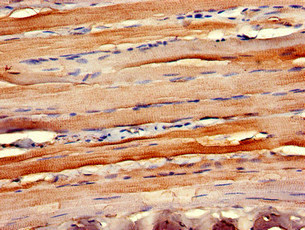CCR10 antibody
GTX70743
ApplicationsImmunoHistoChemistry, ImmunoHistoChemistry Paraffin
Product group Antibodies
ReactivityHuman
TargetCCR10
Overview
- SupplierGeneTex
- Product NameCCR10 antibody
- Delivery Days Customer9
- Application Supplier NoteIHC-P: 3 - 4 microg/ml. IHC-P: 3 - 4 microg/ml. *Optimal dilutions/concentrations should be determined by the researcher.Not tested in other applications.
- ApplicationsImmunoHistoChemistry, ImmunoHistoChemistry Paraffin
- CertificationResearch Use Only
- ClonalityPolyclonal
- Concentration1 mg/ml
- ConjugateUnconjugated
- Gene ID2826
- Target nameCCR10
- Target descriptionC-C motif chemokine receptor 10
- Target synonymsGPR2, C-C chemokine receptor type 10, C-C CKR-10, CC chemokine receptor 10, CC-CKR-10, CCR-10, G-protein coupled receptor 2, chemokine (C-C motif) receptor 10
- HostRabbit
- IsotypeIgG
- Protein IDP46092
- Protein NameC-C chemokine receptor type 10
- Scientific DescriptionChemokines are a group of small (approximately 8 to 14 kD), mostly basic, structurally related molecules that regulate cell trafficking of various types of leukocytes through interactions with a subset of 7-transmembrane, G protein-coupled receptors. Chemokines also play fundamental roles in the development, homeostasis, and function of the immune system, and they have effects on cells of the central nervous system as well as on endothelial cells involved in angiogenesis or angiostasis. Chemokines are divided into 2 major subfamilies, CXC and CC, based on the arrangement of the first 2 of the 4 conserved cysteine residues; the 2 cysteines are separated by a single amino acid in CXC chemokines and are adjacent in CC chemokines. CCR10 is the receptor for CCL27 (SCYA27; MIM 604833); CCR10-CCL27 interactions are involved in T cell-mediated skin inflammation (Homey et al., 2002 [PubMed 11821900]).[supplied by OMIM, Mar 2008]
- ReactivityHuman
- Storage Instruction-20°C or -80°C,2°C to 8°C
- UNSPSC12352203







